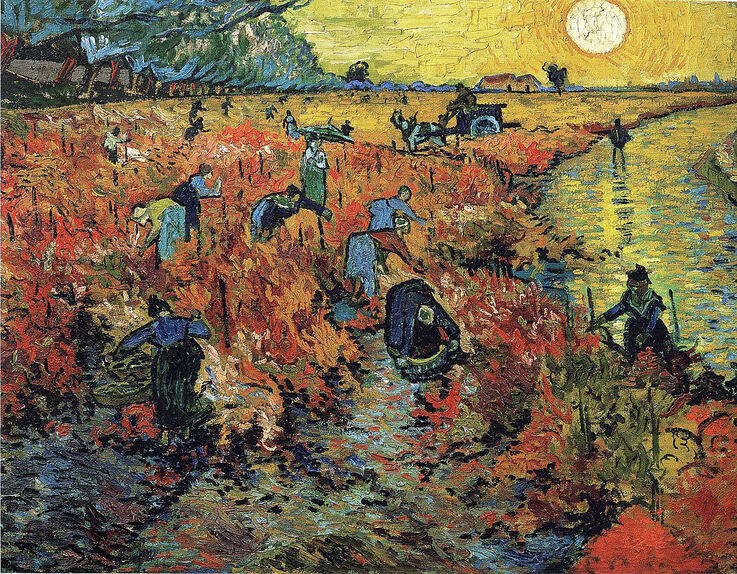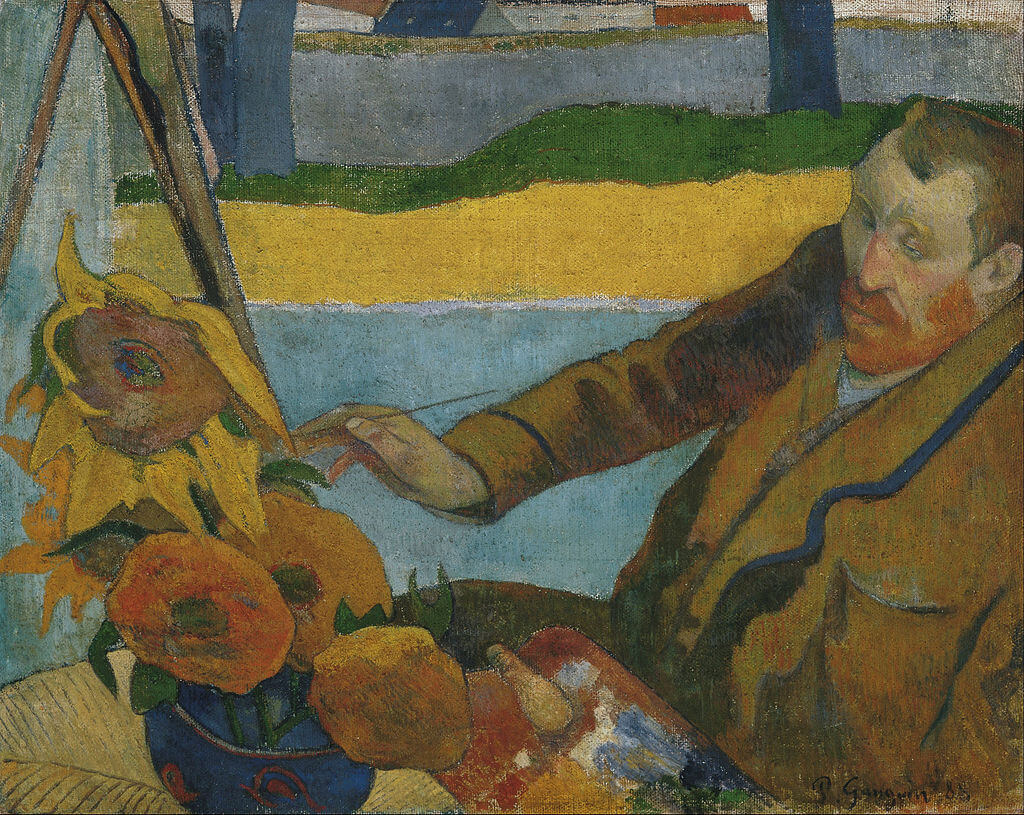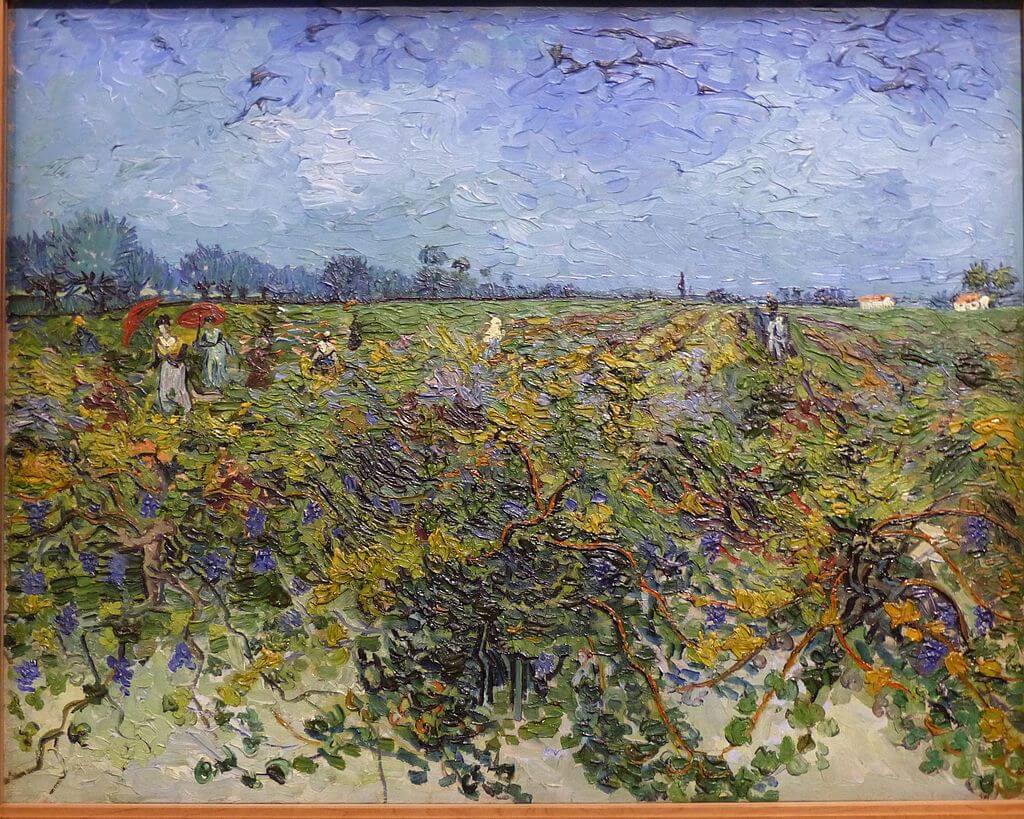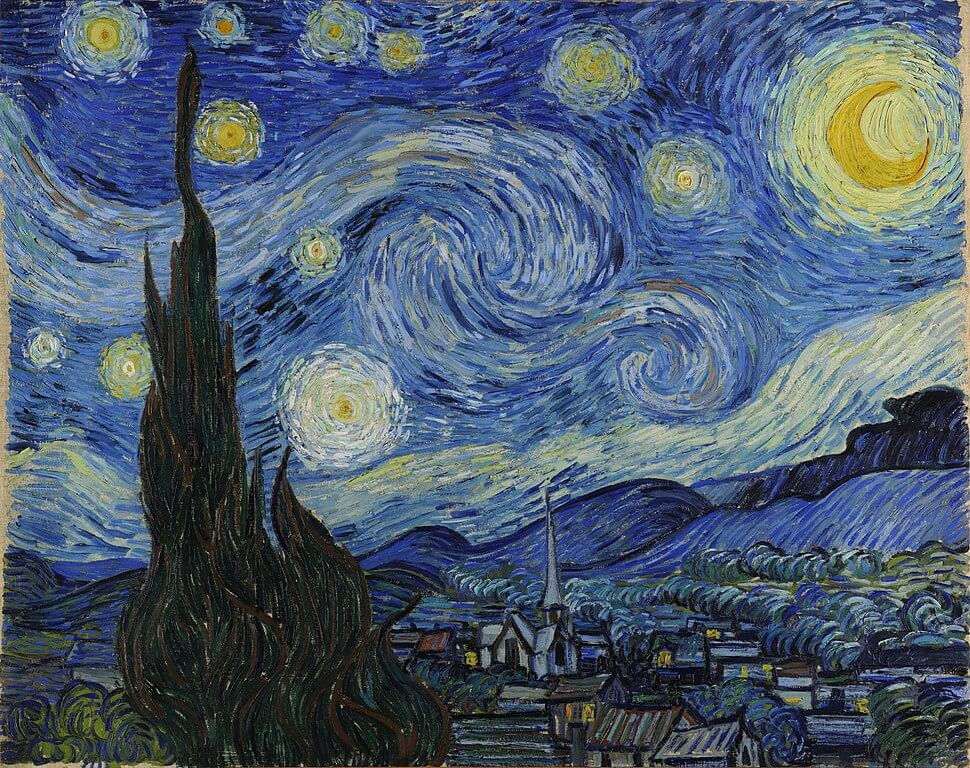|
Where? Second floor of the Department of 19th and 20th Century European and American Art in the Pushkin Museum
When? 1888 What do you see? The vine harvest in Arles, in the South of France. On the top right is the sun in a yellow sky. The sunlight affects the landscape, starting with the gold-colored river on the right side. The sun makes the vine leaves in the bottom half of the painting look red. According to a letter written on November 6, 1888, by Vincent van Gogh to his brother, the vineyard looked like red wine in the sunset. The vineyard in the top half of the painting looks yellow, just as Van Gogh observed it during his stroll through the vineyards. A large number of people, mainly dressed in blue, is working in the vineyard. The workers in the background are depicted as blank silhouettes. The field workers are picking vines during fall. They naturally blend in with the vineyard. On the top left is a series of blue and green trees and in the middle background is a house. Van Gogh used several diagonal lines in his composition and most viewers naturally start looking at the sun when viewing the painting. The viewers’ eyes then move down along the diagonal black line on the left of the river in the direction of the bottom left of the painting. Backstory: This painting is also referred to as The Red Vineyard at Arles. Van Gogh created it in a single day on November 5, 1888. He painted this work about two weeks after Paul Gauguin joined him in Arles. The colorful works of Gauguin inspired Van Gogh to also use more colors for this painting, and he continued to do that in his later works. Van Gogh created this painting from his memory, the day after an evening walk through the vineyards near Arles. Van Gogh liked to work from memory rather than by directly painting from observation as painting from memory gives paintings a more artistic look. The only painting that Gauguin completed during his two-month stay in Arles was The Painter of Sunflowers (Portrait of Vincent van Gogh) which is in the Van Gogh Museum in Amsterdam. In September 1888, Van Gogh also created another painting of the vineyards, called The Green Vineyard. This painting is on display in the Kröller-Müller Museum in The Netherlands.
Symbolism: The main message of this painting is that the people living at the end of the 19th century had to work long days. The workers in this painting are still doing manual labor during sunset at the end of the day. Van Gogh also liked the field workers as they were in sync with nature.
Who is Van Gogh? Vincent Willem van Gogh (1853-1890) was born in Zundert in the south of The Netherlands. He was the oldest of six children who survived birth and grew up in a very religious family. Vincent wanted to become a pastor, like his father, but failed the entrance exam. Instead, he worked for some time as a missionary. His career as an artist was relatively short. Van Gogh only started painting at age 27 on the advice of his brother. In 1888, Gauguin visited Van Gogh in Arles. In anticipation of his visit, Van Gogh created his famous series of sunflower paintings. One of the versions of the Sunflowers is in the National Gallery in London. Another famous painting by Van Gogh, created in 1889, is The Starry Night which is in the Museum of Modern Art in New York.
Fun fact: Van Gogh created about 900 paintings and 1100 drawings during his relatively short career but only sold one painting (at least according to official records). In 1890, he sold The Red Vineyard at an art show in Brussels for 350-400 Belgian Francs to the Belgian artist Anna Boch. This is equivalent to about $1,500 today.
In 1906, Anna Boch sold the painting for 10,000 Belgian Francs to the Russian art collector Sergei Shchukin. The brother of Anna Boch, Eugène Boch, was a friend of Van Gogh. There are theories that Van Gogh may also have sold a few other paintings, but clear evidence for those theories lacks. During his life, Theo, the brother of Vincent van Gogh, supported him financially and tried to promote his work as he was an art dealer. However, Van Gogh’s work was different from the popular Impressionist paintings at that time and was not much in demand. There were a few art critics and artists that appreciated his work, but he was ahead of his time for most of the rest of the people. After his death, his works became much more popular.
Written by Eelco Kappe
References:
3 Comments
Nicole
9/30/2021 02:32:38 pm
Thank you so much for this article! It's been a so helpful.
Reply
11/13/2021 09:45:47 am
I believe the tree-like silhouettes on the horizon are something like the osbourne bull signs in Spain. Though osbourne bull was only created in 1956 and had been dominating after then until now in Spain, in alres where this painting is all about bullfighting had a history.
Reply
liz
2/22/2023 06:09:00 am
you should write about the colour
Reply
Leave a Reply. |
Categories
All
|
- Home
- Blog
-
Museums
- Alte Pinakothek
- Art Institute of Chicago
- Baltimore Museum of Art
- Barber Institute of Fine Arts
- Bargello
- Barnes Foundation
- British Museum
- Church of Sant’Anastasia
- Cleveland Museum of Art
- Courtauld Institute of Art
- Detroit Institute of Arts
- Frans Hals Museum
- Galleria Borghese
- Gallerie dell'Accademia
- Getty Museum
- Guggenheim
- Hermitage Museum
- Kunsthistorisches Museum
- Kunstmuseum Basel
- Legion of Honor Museum
- Louvre
- Mauritshuis
- Metropolitan Museum of Art
- Musee d’Orsay
- Museum of Fine Arts in Boston
- Museum of Modern Art
- National Gallery in London
- National Gallery of Art
- National Museum in Poznań
- Norton Simon Museum
- Ny Carlsberg Glyptotek
- Palace of Versailles
- Palazzo Pitti
- Palazzo Vecchio
- Petit Palais
- Philadelphia Museum of Art
- Prado
- Pushkin Museum
- Ravenna Art Museum
- Rijksmuseum
- San Diego Museum of Art
- Santa Maria delle Grazie
- St. Peter's Basilica
- Städel Museum
- Statens Museum for Kunst
- Tate Britain
- Tate Modern
- Timken Museum of Art
- Uffizi
- Vatican Museums
- Wallace Collection
-
Artists
- Altdorfer
- Anguissola
- Berlin Painter
- Bosch
- Botticelli
- Boucher
- Bronzino
- Bruegel the Elder
- Brunelleschi
- Cabanel
- Caillebotte
- Canova
- Caravaggio
- Carpeaux
- Cezanne
- Cimabue
- David
- Degas
- Delacroix
- De Maria
- Donatello
- El Greco
- Fontana
- Fra Angelico
- Fragonard
- Gauguin
- Gentileschi
- Gericault
- Gonzalez-Torres
- Goya
- Hals
- Hogarth
- Hokusai
- Ingres
- Leonardo da Vinci
- Lippi, Filippo
- Longhi, Barbara
- Lorrain
- Makovsky
- Manet
- Massys
- Matisse
- Merian
- Michelangelo
- Mochi
- Modigliani
- Monet
- Panini
- Parmigianino
- Perugino
- Picasso
- Pisanello
- Raphael
- Rembrandt
- Renoir
- Reynolds
- Rivera
- Rodin
- Rubens
- Scultori
- Seurat
- Steen
- Tintoretto
- Titian
- Toulouse-Lautrec
- Turner
- Uccello
- Van der Weyden
- Van Dyck
- Van Eyck
- Van Gogh
- Van Hemessen
- Vasari
- Velazquez
- Vermeer
- Veronese
- Vigée Le Brun
-
Locations
- Books
- About Us





